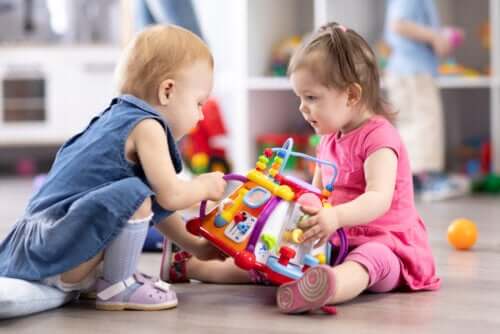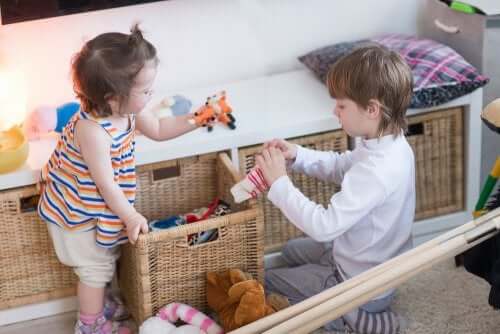Play as a Technique for Evaluation and Diagnosis


Written and verified by the psychologist Elena Sanz Martín
There are many issues that can cause a child to require psychological intervention. However, in these circumstances, many parents ask themselves what to expect during their child’s sessions. It’s important to remember that a child’s mind functions and expresses itself differently from that of an adult. Therefore, psychologists often use play as a technique for evaluation and diagnosis. In fact, it’s one of the practices they use most.
Besides interviews, tests, and questions, play offers us a unique opportunity. Playing is an activity that’s intrinsic in most children. It provides them with a context where they feel safe and comfortable to express themselves freely. Indeed, it constitutes an occasion where a child’s personality, inner world, hopes, and fear come together to form diagnostic play.
Play as a technique for evaluation and treatment
During a psychological consult, specialists can use play both as a means of evaluation as well as a way to treat children. Each case will involve different particularities since the specialist will use different objects. For example, when the psychologist uses play as a treatment technique, he or she will participate in the dynamics by modifying them, offering interpretations, making comments to the child, etc.

However, when the professional uses play as a means of evaluation, it’s the child who will lead play and assign roles. The therapist will simply follow the child’s instructions. In the meantime, the professional will observe the entire process and record the child’s behavior, without intervening.
The design of the playroom allows for children to move about freely and choose whatever items and materials catch their attention. The toys that are in the space will depend on the focus of each professional.
Some child psychologists use more structured articles, like toy phones, doll families, etc. However, others opt for more ambiguous items, like balls, pieces of fabric, pieces of paper, blocks – items that don’t have a clearly defined purpose.
What information does play offer when it comes to evaluating a child?
Play is one of the most direct and effective ways to access a child’s unconscious. By observing their behaviors, we can discover more about their personalities and internal conflicts. But, what should we look at?
How does the child approach the toys?
The way in which a little one acts from the time he or she enters the playroom provides important information. So, in this sense, we must observe how a child approaches the toys that are available.
Does he approach them directly and with determination? Or does he hesitate and keep his distance? Does the child wait for instructions or permission, or grab the toys abruptly and without care.
These observations will help the professional understand, for example, if a child has a dependant or avoidant personality. Or, on the other hand, if he or she possesses elevated confidence. At the same time, the first toy or object that the child chooses is also relevant. Is the toy age-appropriate? What motivated the child to choose the toy in the first place?
How does the child play?
Once the child has chosen an item or items to play with, we can observe how he or she interacts with them. Does she move from one object to another in order to represent a variety of situations? Does she play repeatedly with the same toy?

Is the child able to express him or herself creatively? Does she use symbolic play to depict her thoughts or concept of the world? Or, on the other hand, does she display rigid, monotonous, and repetitive play that involves little imagination?
Furthermore, it’s important to record whether the child seems active or passive during the game. And, in the same way, observe how the child reacts to unexpected events. The way in which little ones face small difficulties will give us an idea of their level of tolerance to frustration.
How does the child assign roles?
Finally, it’s extremely important to pay attention to the roles that children assume. And, in the same way, the roles they assign to the therapist and the toys. If the child assumes the role of an adult, how does he or she behave? This will show his or her concept regarding adult figures in his or her environment.
It’s important to observe how different roles and characters relate to one another and interact under the child’s command. This will tell you about the emotions that characterize the bonds between the child and his or her environment. Is there aggression, guilt, rejection, violence?
Conclusions regarding play as a technique for observation and diagnosis
In conclusion, play constitutes an ideal evaluation technique. It acts as a window through which we can look inside children’s inner world and get to know them on a more profound level. If you have any questions, don’t hesitate to consult a trusted pediatrician or psychologist.
There are many issues that can cause a child to require psychological intervention. However, in these circumstances, many parents ask themselves what to expect during their child’s sessions. It’s important to remember that a child’s mind functions and expresses itself differently from that of an adult. Therefore, psychologists often use play as a technique for evaluation and diagnosis. In fact, it’s one of the practices they use most.
Besides interviews, tests, and questions, play offers us a unique opportunity. Playing is an activity that’s intrinsic in most children. It provides them with a context where they feel safe and comfortable to express themselves freely. Indeed, it constitutes an occasion where a child’s personality, inner world, hopes, and fear come together to form diagnostic play.
Play as a technique for evaluation and treatment
During a psychological consult, specialists can use play both as a means of evaluation as well as a way to treat children. Each case will involve different particularities since the specialist will use different objects. For example, when the psychologist uses play as a treatment technique, he or she will participate in the dynamics by modifying them, offering interpretations, making comments to the child, etc.

However, when the professional uses play as a means of evaluation, it’s the child who will lead play and assign roles. The therapist will simply follow the child’s instructions. In the meantime, the professional will observe the entire process and record the child’s behavior, without intervening.
The design of the playroom allows for children to move about freely and choose whatever items and materials catch their attention. The toys that are in the space will depend on the focus of each professional.
Some child psychologists use more structured articles, like toy phones, doll families, etc. However, others opt for more ambiguous items, like balls, pieces of fabric, pieces of paper, blocks – items that don’t have a clearly defined purpose.
What information does play offer when it comes to evaluating a child?
Play is one of the most direct and effective ways to access a child’s unconscious. By observing their behaviors, we can discover more about their personalities and internal conflicts. But, what should we look at?
How does the child approach the toys?
The way in which a little one acts from the time he or she enters the playroom provides important information. So, in this sense, we must observe how a child approaches the toys that are available.
Does he approach them directly and with determination? Or does he hesitate and keep his distance? Does the child wait for instructions or permission, or grab the toys abruptly and without care.
These observations will help the professional understand, for example, if a child has a dependant or avoidant personality. Or, on the other hand, if he or she possesses elevated confidence. At the same time, the first toy or object that the child chooses is also relevant. Is the toy age-appropriate? What motivated the child to choose the toy in the first place?
How does the child play?
Once the child has chosen an item or items to play with, we can observe how he or she interacts with them. Does she move from one object to another in order to represent a variety of situations? Does she play repeatedly with the same toy?

Is the child able to express him or herself creatively? Does she use symbolic play to depict her thoughts or concept of the world? Or, on the other hand, does she display rigid, monotonous, and repetitive play that involves little imagination?
Furthermore, it’s important to record whether the child seems active or passive during the game. And, in the same way, observe how the child reacts to unexpected events. The way in which little ones face small difficulties will give us an idea of their level of tolerance to frustration.
How does the child assign roles?
Finally, it’s extremely important to pay attention to the roles that children assume. And, in the same way, the roles they assign to the therapist and the toys. If the child assumes the role of an adult, how does he or she behave? This will show his or her concept regarding adult figures in his or her environment.
It’s important to observe how different roles and characters relate to one another and interact under the child’s command. This will tell you about the emotions that characterize the bonds between the child and his or her environment. Is there aggression, guilt, rejection, violence?
Conclusions regarding play as a technique for observation and diagnosis
In conclusion, play constitutes an ideal evaluation technique. It acts as a window through which we can look inside children’s inner world and get to know them on a more profound level. If you have any questions, don’t hesitate to consult a trusted pediatrician or psychologist.
All cited sources were thoroughly reviewed by our team to ensure their quality, reliability, currency, and validity. The bibliography of this article was considered reliable and of academic or scientific accuracy.
- Klein, M. (1955). La técnica psicoanalítica del juego: su historia y significado. Obras completas, 3, 129-146.
- Pietramala, K., & Simó, L. B. HORA DE JUEGO DIAGNÓSTICA.
This text is provided for informational purposes only and does not replace consultation with a professional. If in doubt, consult your specialist.








